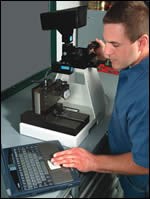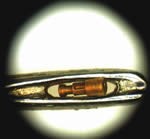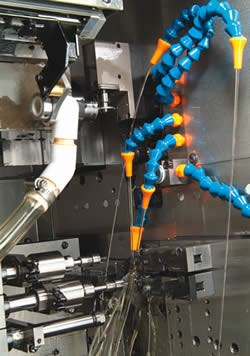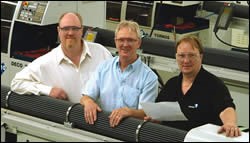Making It Big In Small Parts
This New Hampshire manufacturer is an expert in manufacturing small, complex parts. Having a niche is one solid strategy for survival, but it takes dedication, focus and technology to pull it off.
Barry Podmore enjoyed a laugh when he inquired about an equipment company’s definition of micromachining, which it understood as machining quarter-inch-diameter parts.
“In our world, quarter-inch diameters are considered huge,” chuckles Barry Podmore, president and owner of Barry Podmore, Inc. (Pittsfield, New Hampshire). “That’s the largest size of raw material we use, never mind the parts. Some of our parts have a major diameter of 0.010 inch.”
As a precision machined parts supplier, the company has earned a reputation throughout the last 25 years as a facility that can produce these small parts for the electronics, automotive and aerospace industries. As the end products get smaller and more complex, the technology with which the company produces the parts has become more sophisticated and efficient.
“I started out in 1982 with three Escomatic cam machines. My background is designing and cutting cams for Escos, so it made sense to continue doing what I knew best when I struck out on my own,” says Mr. Podmore, who came to America in 1976 from England with his wife and three small children.
The company’s first location was practically a garage in his front yard. While the shop provided a quick commute from his house, the company outgrew the space, and in 2000, purchased and renovated a 17,000-square-foot facility in Pittsfield.
The newest location includes dozens of cam and CNC Escomatics lined up like soldiers, along with eight Deco CNC Swiss machines from Tornos Technologies U.S. Corp. (Brookfield, Connecticut). All of the machines look brand new, even though some of the Escos are decades old and have been kept very busy. This year alone, the company expects to produce almost 100,000,000 parts.
Finding A Niche
“There are very few companies that can do what we do,” Mr. Podmore says. “Fortunately, we have the technology and bright people who can keep up with our customers’ demands for more parts that are plus or minus perfect and delivered on time.”
In the electronics test and measurement market, the company makes plungers for spring-loaded pogo probes for testing electronic circuitry. In the test fixture, these probes look like a bed of nails, but when looking at these parts under a microscope, one can see they are intricate, some with holes, three-sided chisel heads, four-point crowns, nine-point serrations, and so on, for a variety of circuits of different shapes and sizes. There can be thousands of these tiny wear parts in one test fixture, depending on the size of the circuit board and/or how many boards are being tested at once. It’s a good job, but hard to make.
“Micromachining is growing, not necessarily because we as a company want to do it, but because it’s what our customers demand,” Mr. Podmore says. “When we first started doing these, we produced plungers for what the industry refers to as ‘hundred mil grid pattern,’ which is a hundred thousandths of an inch on center. Then, we made parts for 50 mil, then 25 mil and now 10 mil. The grid pattern keeps getting closer and closer, so naturally, the test probes have to follow suit. It’s like, ‘honey, I shrunk the parts,’ again.”
Over time, these parts have not only gotten smaller, but they are also getting more complex. When the shop first began making them, the probes had fairly simple tip styles and the Escos accommodated them fine. The simpler tips are still running on those machines day and night. In fact, one machine has run one part continuously for 12 years. All of Podmore’s machines, including the Swiss-types, run 24 hours with “lights out” from about 10 p.m. to 5:30 a.m.
“We won’t take a job if we can’t run it for 24 hours,” Mr. Podmore says.
Although Mr. Podmore was comfortable with the cam actuation, he did take a leap to CNC Escos, with nudges by sons Wayne and Kerry, when he needed more flexibility for shorter runs. He recently added the model Mach 649, which is a full CNC machine.
Dealing With Complexity
“About 4 years ago, it became clear we needed to go up several sophistication levels if we wanted to get the more complex work that was out there,” he explains. “We purchased our first CNC Tornos Swiss-type—a 10-mm, nine-axis machine. Now we have eight of them. Our customers are pushing us to do additional work, so we may have to expand the building and get even more machines,” Mr. Podmore adds.
The ability to perform polygon milling is one of the machine features most commented on by Barry Podmore, Inc.’s owners. Polygon milling can be accomplished in both the main and subspindle on these Swiss-types. The part spindle and the live tool spindle synchronization are keys for successful “polygonning.”
Elaborating on the operation sequence, Wayne goes step-by-step through a typical application. The part isn’t necessarily the smallest part produced in the shop, but the beryllium copper test probe barrel has numerous features on it for its size, which is 0.084 inch long and 0.030-inch major diameter.
The first operation is to spot and drill a 0.016-inch-diameter hole on the front end of the part that goes to a depth of 0.060 inch. The critical tolerance on the ID, OD and length is 0.0005 inch, which is common for this company. At one point, the Swiss-type machines held a 15,000 part run to ± 0.000080 inch.
The next operation is turning the first length down to 0.020 inch, and then putting in a cross drill hole of 0.007 inch. Tooling is a considerable issue with micromachining. The company developed a 0.010-inch cross drill that can drill IDs virtually burr-free.
“I break more tools simply handling them than the machine does. We have very little breakage on the machine,” Wayne Podmore explains.
Next, the remainder of the part is turned down to a 0.014-inch diameter, and the pickoff spindle cuts off the part from the bar and transfers the part to the top of the work area to expose the back end of the part for polygon milling the four-point crown, and the part is complete. Meanwhile the main spindle operations are underway on a new part. Cycle time per part is less than 25 seconds.
“I can’t stress enough how important the synchronization is between the spindle and the live polygon attachment. To get the four points, the cutter has to rotate four times faster than the spindle, exactly, perfectly burr-free, which they have to be, and the machine does it every time,” Wayne says, who also programs the Swiss-types using the OEM’s proprietary software. “The programming is different, but I think it’s different in a positive way. The way the software is laid out, I have better visualization of each operation than with conventional ISO programming and can see what each axis is doing. The bottom line is it helps to cut cycle time. It’s one more tool that’s available for programmers to help eliminate dead time and use that time for tool changes. It makes sense to me and did from the first time I used it.”
More Than Machines
Machining minute parts impacts the entire manufacturing process and even the company culture. It’s more than having the right machines. The actual cutting tools are an important aspect for success. Barry Podmore, Inc. sometimes makes its own or uses a handful of resources. The polygon tools and the custom drills, for example, are made in Switzerland.
“We also have to do some work on the collets ourselves,” Kerry Podmore adds. “Any imperfection in the collet is going to create an imperfection on the part. If, for example, the collet has a miniscule ding or if its concentricity is only 0.0005 inch off center, the part is scrap. If concentricity is off by 0.001 inch on a 0.25-inch part, you won’t even see it, but when you are talking about a 0.012-inch-diameter part, it’s a big percentage.”
Other differences with micro-parts are the options to accomplish post-processing tasks such as cleaning, heat treating, finishing and inspection. The company has found that conventional methods simply aren’t appropriate for parts that, when viewed with the naked eye, look like tiny shards of swarf. The company uses ultrasonic cleaners, chemical etching when a special edge or finish is required, and microscopes, laser micrometers and video inspection for random batch inspection.
“Perhaps most importantly, along with all of the technology, you must have the skilled people attuned to the mindset of making these small parts,” Mr. Podmore explains. “It’s not for everyone, and it takes more than a few months of training. It’s engrained in our culture. It’s who we are. However, it’s also about finding outside vendors and suppliers who understand what we are trying to do and have the technological depth of knowledge in both process and product to help us be successful.”
Related Content
PMTS 2023 Product Preview: Swiss-Types
Learn about some of the latest Swiss-type solutions that will be on display at PMTS 2023.
Read MoreStories of Swiss First Additions
A handful of shops share their stories about the how’s and why’s of adding their first Swiss-type CNC turning centers.
Read MoreMoldmaker Finds Value in Swiss-Type Machining
This multifaceted manufacturer has added CNC sliding-headstock turning technology to complement its established mold tooling production and new injection molding capabilities as it continues to pursue complex medical work along a vertically integrated path.
Read MorePursuit of Parts Collector Spearheads New Enterprise
While searching for a small parts accumulator for Swiss-type lathes, this machine shop CEO not only found what he was looking for but also discovered how to become a distributor for the unique product.
Read MoreRead Next
A Different Way To Turn
The Esco concept turns turning 180 degrees. Unlike conventional lathes, the material, which is coil stock or bar from 0.02 mm to 12 mm, does not rotate. Stationary stock allows the use of round and profiled material.
Read MoreEmerging Leaders Nominations Now Open
Here’s your chance to highlight a young person in your manufacturing business who is on the path to be a future leader moving your company forward.
Read MoreA Tooling Workshop Worth a Visit
Marubeni Citizen-Cincom’s tooling and accessory workshop offers a chance to learn more about ancillary devices that can boost machining efficiency and capability.
Read More













.jpg;maxWidth=300;quality=90)




.jpg;maxWidth=300;quality=90)








